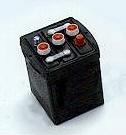

![]()
 |

|
|
 FAQ on
Converting
FAQ on
ConvertingOne of the most frequently ask questions we get are, "How do I upgrade to 12 volts". The 12 volt upgrade is probably the easiest and least expensive project. Before we get into the project, I would like to share a few of the most frequently asked questions.
Q: When I go to 12 Volts will I have to change my wiring or go with a larger size wire?
A: No, if your wiring is in good physical condition, there is no need to change wire sizes. Load amperage will drop by approximately 50% when changing from 6 to 12 volts.
Q: Will I have to change the starter to 12 Volt.?
A: I most cases you will not have to change the starter. If a starting solenoid is used to engage the starter, it will need to be changed. If the starter is in poor condition with worn bushings and brushes, the upgrade to 12 volt may hasten it�s failure. In most cases it improves starting.
Q: I have a positive ground system, what do I need to do when changing to 12 volts?
A: Your best low buck option here is to run an inverter to keep the items you want positive grounded.
OK, lets get down to the project. As an overview to this project, we will cover the four basic areas needed to complete this project. These parts are the Charging System, Instrumentation System, Starting System and Lighting System.
The question of generator or alternator is one of, what is best for your needs. While 12 volt generators are used less often, a 12 volt generator makes it simple swap by changing out the 6 volt generator and voltage regulator. The amp meter will work fine on 12 volts, and give accurate readings. This would complete the Charging System phase of your project with no visible changes to the engine compartment. Another advantage of a generator over an alternator is that it will charge a dead flat battery.
A one wire alternator with built in regulator, which eliminates a lot of hardware, is easy to install as far as engine wiring goes. The old regulator and wiring can be removed, which cleans up the engine compartment. Usually, a bracket modification is required on most engines to fit an alternator. Aftermarket alternator brackets are available for most of the older 6 cylinder and V-8 engines. If you are even a little handy, you can modify the existing bracket to fit the new alternator by welding on a mounting boss.
To complete the Charging System you will need a 12 volt battery. Select one that meets your engine�s needs and battery box limitations. We recommend the new glass mat batteries by Optima.
As stated earlier, the Amp meter will work just fine and read correctly on 12 volts. The fuel gauge will need to have a dropping resistor attached between the positive terminal and the positive wire supply power to the gauge. This type of dropping resistor is available from most of the classic truck parts suppliers for about $10.00. Do not use the large load dropping resistor. You will need to run a fan and wiper motors. As most older trucks use mechanical oil senders, so there is nothing to do here.
Next, all the instrument light bulbs need to be changed to 12 volt. If you forget this part, you will be reminded one night in a bright flash and drive home in the dark.
Don�t for get the radio if you have one. The best way to handle to power requirements for a 6 volt radio, would be to contact your local automotive radio repair shop. I know that operating a 6 volt, tube type radio off a dropping resistor is bad news. Supply wire sizes also are factors to take into consideration. This is an area best left up to the experts, if you can find one.
Heater and Wiper motors will need a heavy load, ceramic dropping resistor. Mount the resistor in the engine area, as it emits a lot of heat. Buy a good one, big, with a good ceramic heat sink. Any NAPA dealer can supply this item as well as many of the vintage truck parts suppliers for around $45.00. The part is made by Echlin and the part number is BT-6187. Tie all your motor loads to this resistor and use the proper size wire for the loads you are running. If you can handle the expense, you may want to replace the old heater and wiper motors with new 12 volt models. Replacement of these motors will save you time and the need to rewire.
Positive ground trucks link GMC and Ford with require an inverter to properly power the instruments. You can inverters large enough to run everything you want to keep positive grounded. Inverters are usually cost less than converting instruments to negative grounding and replacing radios and wiper motors with negative ground units..
This part is probably the easiest. If you have a starting solenoid for your starter, change it to 12 volts. The 6 volt starter will work fine on 12 volts, sometimes better. It is hard sometimes to find 12 volt starters for older trucks, so if you have to replace a worn starter, there is no problem with using an original 6 volt starter.
Positive ground starters present problems in some cases. If you cannot find a negative ground starter that will fit your application, you may need to seek out a good auto electrical repair shop to have the motor leads reversed. You can do this your self, but if you are not confident in your work, seek professional help.
You will need to add a ceramic ballast resister to your 6 volt ignition coil. A firewall mounted resistor, such as thoughts use on early 12 volt GM products are the easiest. These resistors are available from Napa Auto Parts for about $10.00.( Napa Part Echlin ICR-13) The resistor is installed inline on the 12 volts supply to the distributor dropping the ignition to 6 volts.
This area too, is pretty straight forward and is really here just as a reminder. Remember to change your Headlamps, Map, Courtesy, Brake, Turning and Parking lamps. One thing I really like to do when going 12 volts, is to use Halogen Headlight lamps and bright bulbs in the Brake & Turning lamps. Original Brake and Turning lamps are usually pretty small as far as today�s standards are concerned and bright bulbs really help you be seen at night. Halogen Headlights will also greatly improve your night vision and get rid of that old yellow look associated with older vehicles.
![]()
The format, and possibly the content of this article has been modified.
Special Thanks to
Classic Truck Shop for this article.
![]()
Copyright �
September, 2019
San Jose Classic Chevys